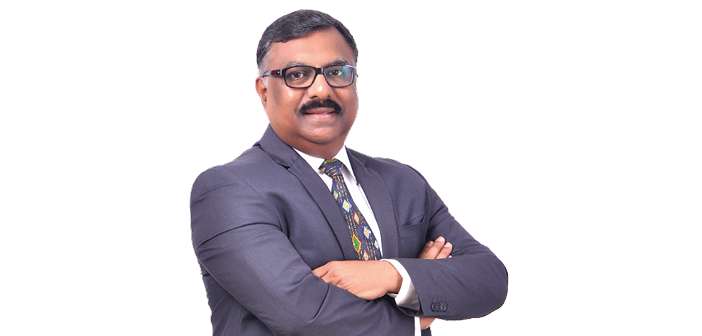Can you give some background into your career so far?
I’m a graduate in science, have an MBA in sales and marketing, international business, and a PhD in aircraft maintenance – all from premium institutions here in India. I’ve headed organisations as CEO and vice president in Singapore, the UAE and India.
My journey in aircraft interiors started in 2005-6, representing a company launching seats to airlines in the South Asia region. These customers wanted us to handle the seat maintenance after the warranty period, so in collaboration with somebody in Singapore, we set up an interior refurbishment facility in India and other places.
Business jet customers started approaching us from 2009. We started with seat upholstery and moved to carpets, then wood veneer lacquering, plating and everything related to cabin materials, then started handling the lav and galleys. Slowly, I gained recognition as a specialist in business jet interiors in South Asia and the Middle East. There are more than 200 technicians trained under me currently working for aircraft interior facilities around the Middle East, South Asia and Asia Pacific – that’s how my reach to these MROs increased.
What interior services do you offer at AeroChamp Aviation?
We are a consultancy, advising on material selection and modifications, technical compliance, and coordinating with the MRO to get that executed.
In 2018 we handled the first major cabin modification in the Middle East and Asia, which included a complete IFE replacement, installing Inmarsat antenna for wi-fi, and a major galley modification. It was the first project where we drilled the fuselage, and I got the STC made and approved by the local regulatory authorities.
What is the process of certification like in this region?
For any minor or major modification, we need an EASA- or FAA-approved DOA or DER to issue the STC. When we get the STC back on the basis of the recommendation of the OEM (because they give all the engineering back-up support), these STCs are brought to the local regulatory authorities, which could be DGCA or GCAA, and they endorse the STCs before the Part 145 MRO carries out the work.
Do you have plans for how you’d like to expand?
It would be wonderful to consult MROs in Southeast Asia and the Middle East [and help them develop]. Slowly the region is developing; some major cabin repairs are happening here. The next step for these MROs is to get into electronic modifications, for example involving avionics, inflight entertainment, mood lighting and cabin wi-fi.
Several of the smaller interior facilities are badly impacted by the pandemic. One way for them to generate more revenue is to enhance their capabilities. They don’t need people to do that: my team can execute projects for them.
There are many facilities that can upgrade themselves to carry out modifications. Currently the biggest challenge is getting the STC even for minor mods; there is hardly any Part 21 G or J capability in this region, because the regulatory authorities are themselves not equipped to authorise facilities for Part 21. For one major project, I got the STC from a DOA under EASA, and the STC was endorsed here so we could carry out the project. We are already partnering with some of the DAOs from Europe and DERs from the USA to provide cabin upgrade and modification in this region with the STC and all the technical and engineering support.
Are there changes you’d like to see to the structure of the industry?
There are three categories of work. There is refurbishment involving changing soft goods and some of the sidewall panels. The second level is upgrade and modification, which is more technical and involves more revenue. The third level is completion, where you install everything in the aircraft.
The business jet interiors industry is still in the nascent stage in this region. There is plenty of skill, manpower and technical knowledge, but it needs to be tapped, enhanced to the level of modifications. Then maybe 10 or 20 years down the line we will see a completion centre in this region.
Is there sufficient demand in the market to justify building this capacity?
Based on my research, we can say a business jet has to go for refurbishment every six to seven years here because of the climate – it’s humid and hot. If there are say 5,000 business jets in this region, and only 25% of them go for upgrade or modification, there are potentially 1,250 aircraft coming up for upgrade or modification, each of which would cost no less than a million dollars on average. This is surely a reason for facilities to consider upgrading to be able to offer cabin modifications.
There is now an interior refurbishment centre in Singapore. Before that opened, everybody used to take their aircraft to Europe or the USA. Similarly, there are European interior refurbishment shops trying to extend capabilities in Dubai. I’m sure that in the next year or two there’ll be a major refurbishment and modification centre in Dubai.
IFE systems now are being replaced every 8-10 years to keep up with technological changes. Some people still have CD players on their aircraft and wired IFE system, so they need to upgrade to wi-fi. There is surely a need for maybe two or three interior modification shops.
Are there any challenges unique to service providers in these regions?
Material availability and lead times are a challenge. Most interior material suppliers and technology partners are based in Europe and the USA. It’s impossible to carry out an unscheduled refurbishment or modification here.
The second challenge is the time zone differences involved in working with people in the West. Purchasing managers in refurbishment shops here have to make calls at night to coordinate materials. Local contacts would make things very easy for the refurbishment centres here, and enhance their capability and confidence in executing such projects.
The third challenge is that there is no schedule or CMM for replacing soft goods. The refurbishment centre has to be capable of developing a procedure sheet, getting it approved by the regulatory authority, and also establishing durability. Somebody trying to develop wood lacquering capabilities has to do a lot of trials. What if the veneer turns milky, cracks or delaminates? It’s not as simple as offering a free re-lacquering service, the problem is the grounding of the aircraft, the hiring of the MRO, the hangar, and everything has to be removed and re-lacquered. That’s a challenge OEMs could help with, coming forward to help local facilities extend their capabilities.
Would you like to see companies in the region cooperating?
Yes. We don’t need every capability to be developed by every facility. They need to form a kind of association so they can promote each other’s capabilities. This would be great for all of them; they can all grow together. But more than that, there is a huge opportunity for well-established refurbishment or completion centres in the West to collaborate with them, enhance their capabilities and share the revenue.
Most, if not all of this region’s regulators follow EASA; all the regulatory documents are kind of a replica of EASA’s, with some nominal local modifications, maybe a 10% change. If somebody is comfortable with EASA processes I don’t think there will be a challenge for them to collaborate in this region.
How has the pandemic impacted demand?
The pandemic has hit the whole world, but the business aviation industry in this region is young and recovering very quickly. The desire to grow is so strong that I anticipate it coming back to normal by the end of 2021 or mid 2022, if things go the same way as they are now.
This is the time to bring in those big giants to collaborate with the small players here and create something big in this region.
There is a strong desire to grow and great flexibility here. This flexibility is one of the very good qualities that is taking this region on a path to very high growth.
What is the breakdown of business jet owners in the region?
Fractional ownership has not been very successful here. People who can own a business jet don’t want to share it, and the ones who are rich enough to take a business trip, but not own an aircraft, fly on a charter. I would say it’s 50-50 between private and charter.
Are there enough business airports to support the industry?
This region has hardly any business airports, it has FBOs based at commercial airports. I can count probably four or five general aviation terminals in the region. Singapore has Seletar Airport and the UAE has two business airports.
Are there challenges in terms of getting landing slots?
Some countries have curfew hours, whereby the commercial airlines can fly any time, but the business jets have fixed hours when they can take-off and land. That’s a little bit of a challenge, but I think over time, as most of the big cities get second airports nearby, that’ll be eased.
Is there anything else you wanted to talk about?
This region has been ignored for too long in terms of developing local capabilities. Why should an aircraft fly all the way from here to Europe or the USA just to go for a refurbishment? Because many MROs do not want to get into something outside the scope of the aircraft maintenance manual, and because they don’t have enough properly trained manpower available.
In the West, when the aircraft is six or seven years old, the owner decides to refurbish it straightaway. This is probably because he can afford to do it or because the MRO has made the case for getting everything done in one go while the aircraft is grounded.
That is a gap in the market that Bombardier and Flying Colours have explored together in Singapore and they’re doing well. We need to improve coordination between the MROs and both suppliers and OEMs, as well as see some more well-established names in interior refurbishment coming forward to form joint ventures here. It may take a little bit of investment and time, but in the long term that is going to be a huge revenue generator.
Dr. Praveen Srivastava specialises in MRO consultancy and is recognised as a business jet interior expert in the Middle East, South Asia and Asia Pacific region. He carries vast knowledge of materials science and has developed several application procedures accounting for the local climatic conditions.
A full feature on the outlook for the business jet interiors industry in Asia is available to read here, in the July 2021 edition of Business Jet Interiors International.


2 Responses
Respected Sir,
It was a wonderful, studious and high flying feeling to go through all your work experiences, aviation knowledge and all about aviation industry. You have very openly discussed and touched all the aspects pertaining to this industry. I am very sure, with the aero experts like you, the days are not far away for our aviation sector, to come up with flying culours and compete with the world’s dominant companies.
Sir, I am an Indian Air Force veteran, having served 20 years in Mechanical stream and bestowed with opportunities to work on various fighters and related systems. Out of my 20 years, I am amongst those few, who had an opportunity to work 11 long years in one fighter- Mirage-2000.
Presently, I am discharging my duties and responsibilities as a State Tax Officer in GST Department, Maharashtra state and posted at Konkan Bhavan, Belapur, Navi Mumbai.
It would be my pleasure, to be associated with you and your esteemed Organization, in any position, which you think might be suitable.
Thanks & Regards
Thanks Mr. Ashok Kamble, your comments are appreciated. Pl. apply for suitable post through our careers page. Wish you all the very best.